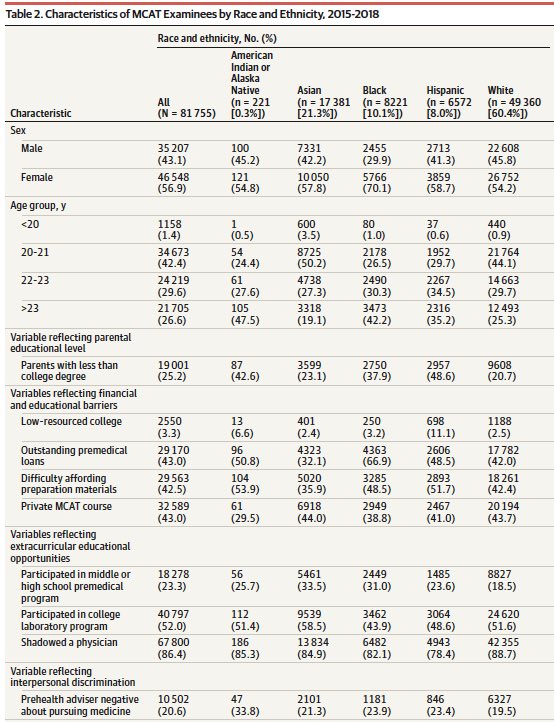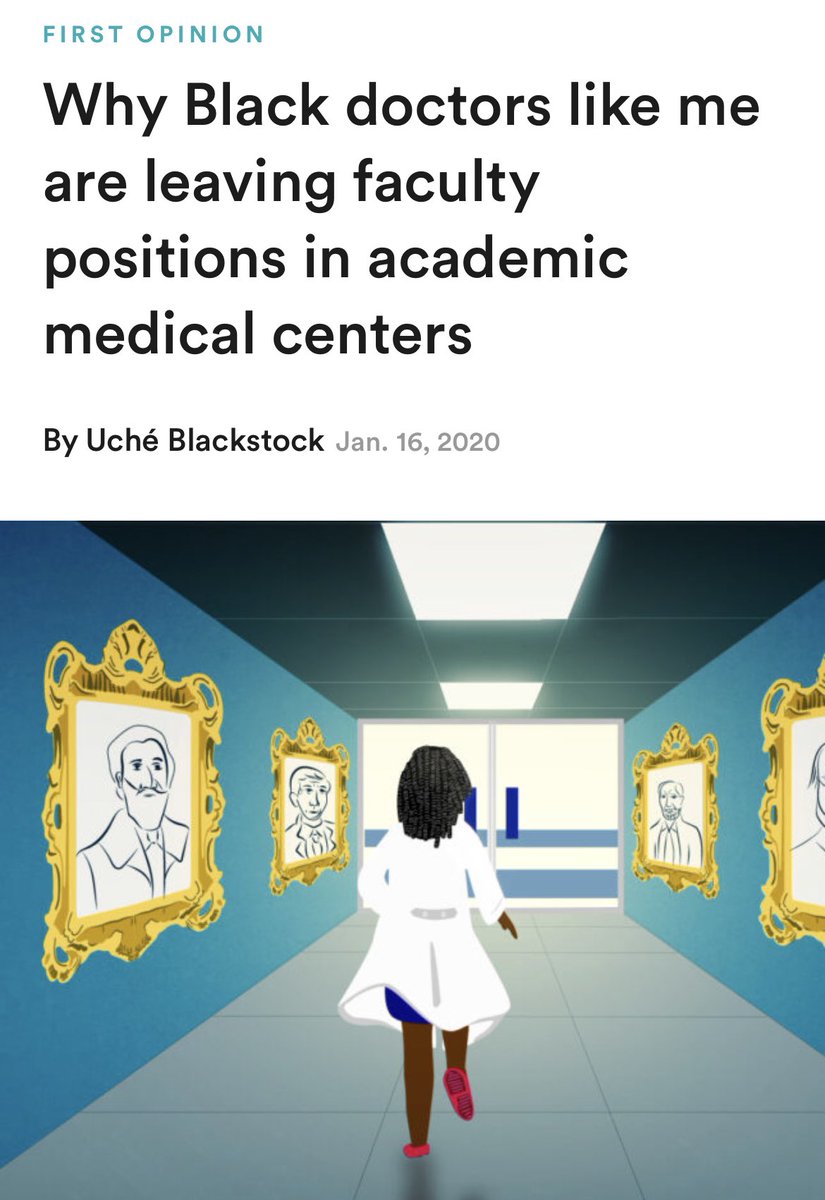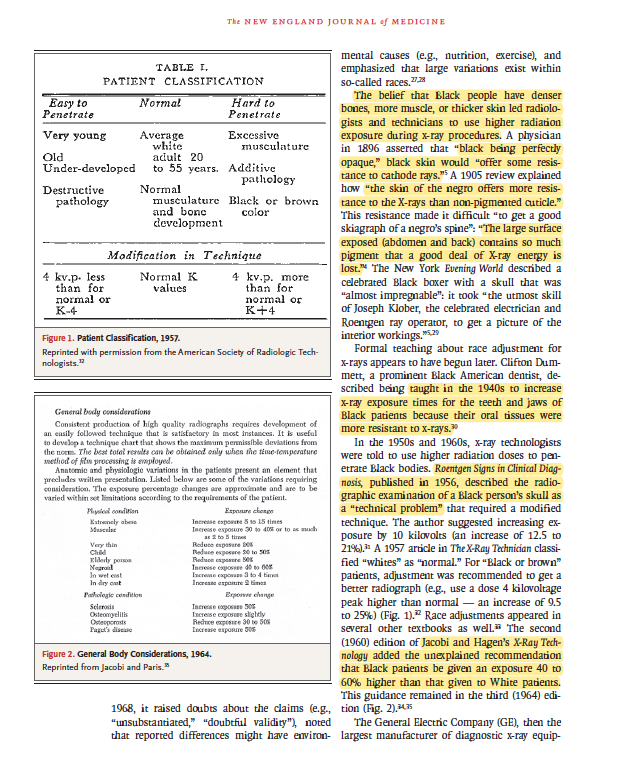1/ 🧵 NEW Paper.
We asked: Are there racial & ethnic differences in barriers to applying to & enrolling in med school and do those affect med school diversity?
TL;DR: Black & Hispanic students were less likely to apply & enroll and faced more barriers.
jamanetwork.com/journals/jama-…

We asked: Are there racial & ethnic differences in barriers to applying to & enrolling in med school and do those affect med school diversity?
TL;DR: Black & Hispanic students were less likely to apply & enroll and faced more barriers.
jamanetwork.com/journals/jama-…


2/ First, who did we study?
This was a study of >81,000 MCAT examinees (0.3% American Indian or Alaska Native, 21.3% Asian, 10.1% Black, 8.0% Hispanic, and 60.4% White) from 2015-2018.
I don’t know about y’all, but this was *the* hardest test I took. 😳
jamanetwork.com/journals/jama-…
This was a study of >81,000 MCAT examinees (0.3% American Indian or Alaska Native, 21.3% Asian, 10.1% Black, 8.0% Hispanic, and 60.4% White) from 2015-2018.
I don’t know about y’all, but this was *the* hardest test I took. 😳
jamanetwork.com/journals/jama-…

3/ Next, what did we find?
1️⃣ Black (77.8%) & Hispanic examinees (71.3%) were ⬇️ likely than White examinees (80.2%) to apply to med school.
Black (40.6%) & Hispanic examinees (40.2%) were also ⬇️ likely than White examinees (45.0%) to matriculate.
jamanetwork.com/journals/jama-…
1️⃣ Black (77.8%) & Hispanic examinees (71.3%) were ⬇️ likely than White examinees (80.2%) to apply to med school.
Black (40.6%) & Hispanic examinees (40.2%) were also ⬇️ likely than White examinees (45.0%) to matriculate.
jamanetwork.com/journals/jama-…

4/ 2️⃣ We found that American Indian / Alaska Native, Black & Hispanic students had more barriers to med school:
🚩⬇️ Parents with a college degree
🚩⬆️ Premed loans
🚩⬆️ Difficulty affording test prep
🚩⬇️ College lab / MD shadowing
🚩⬆️ Advisor negative about becoming 👩🏾⚕️👨🏽⚕️
🚩⬇️ Parents with a college degree
🚩⬆️ Premed loans
🚩⬆️ Difficulty affording test prep
🚩⬇️ College lab / MD shadowing
🚩⬆️ Advisor negative about becoming 👩🏾⚕️👨🏽⚕️

5/ 3️⃣ We found that Black (13%) and Hispanic (39%) examiners were less likely to apply and less likely to matriculate (17% & 18% respectively).
But when we add the financial, education & discrimination barriers to our model, those differences disappear.
jamanetwork.com/journals/jama-…
But when we add the financial, education & discrimination barriers to our model, those differences disappear.
jamanetwork.com/journals/jama-…

6/ Finally, why does this matter & what can we do?
1️⃣ Diversity in medicine saves lives. We’ve now had several studies to support this.
We have to preserve race-conscious admissions. And since the Supreme Court won’t do it, what will your med school do?
jamanetwork.com/journals/jaman…

1️⃣ Diversity in medicine saves lives. We’ve now had several studies to support this.
We have to preserve race-conscious admissions. And since the Supreme Court won’t do it, what will your med school do?
jamanetwork.com/journals/jaman…


7/ 2️⃣ We have to eliminate economic barrier to applying to and matriculating at medical school.
@davidevelasqu puts in perfectly in his NYT OpEd.
And with the unequal distribution of wealth in our country, this is absolutely a racial Justice issue.
nytimes.com/2019/11/25/hea…

@davidevelasqu puts in perfectly in his NYT OpEd.
And with the unequal distribution of wealth in our country, this is absolutely a racial Justice issue.
nytimes.com/2019/11/25/hea…


8/ 3️⃣ Finally, we need bold, antiracist approaches to every single step in the med school admissions process (and likely *much* earlier).
NEJM: nejm.org/doi/full/10.10…
JAMA: jamanetwork.com/journals/jama/…
STAT: statnews.com/2020/01/16/bla… @uche_blackstock
CNN: amp.cnn.com/cnn/2023/02/21…



NEJM: nejm.org/doi/full/10.10…
JAMA: jamanetwork.com/journals/jama/…
STAT: statnews.com/2020/01/16/bla… @uche_blackstock
CNN: amp.cnn.com/cnn/2023/02/21…




9/9 🙏🏾 Dr. Faiz (@im_jesssayinn) and Ly (@meddly) for leading us on this 📝.
Many did not need another study to highlight something “we been knew” but it’s important for science to support our stories.
cc @oni_blackstock @ushamcfarling @ElohoUfomata
jamanetwork.com/journals/jama-…

Many did not need another study to highlight something “we been knew” but it’s important for science to support our stories.
cc @oni_blackstock @ushamcfarling @ElohoUfomata
jamanetwork.com/journals/jama-…


P.S. For more context on our paper, check out the commentary from @jayaaysola @SIbrahimMD: jamanetwork.com/journals/jama-…
Also, don’t miss the @UCLAHealth press release with some great quotes from our fearless leader @im_jesssayinn: uclahealth.org/news/students-…

Also, don’t miss the @UCLAHealth press release with some great quotes from our fearless leader @im_jesssayinn: uclahealth.org/news/students-…


PPS. Check out the summary from @vlocarmen @Forbes on our findings. 👇🏾
cc @EbonyJHilton_MD @mayaaking @LarryRJacksonII @DarilynMoyer @InginiaGenao @AliciaFMD @KBibbinsDomingo @KemiDoll @Rasheeda_HallMD @IssakaMD @teni_brown @DrAlethaMaybank @DrKamLeigh
forbes.com/sites/victorlo…
cc @EbonyJHilton_MD @mayaaking @LarryRJacksonII @DarilynMoyer @InginiaGenao @AliciaFMD @KBibbinsDomingo @KemiDoll @Rasheeda_HallMD @IssakaMD @teni_brown @DrAlethaMaybank @DrKamLeigh
forbes.com/sites/victorlo…
PPPS. If one 🧵 wasn’t enough, here’s @im_jesssayinn’s thread on our paper, sharing the journey from research idea to published manuscript, all inspired by a career committed to #DiversityinMedicine.👇🏾
As someone who went thru fellowship without a single 📝, this is a 🔥 feat!
As someone who went thru fellowship without a single 📝, this is a 🔥 feat!
https://twitter.com/im_jesssayinn/status/1646893263159447553
• • •
Missing some Tweet in this thread? You can try to
force a refresh

 Read on Twitter
Read on Twitter



























